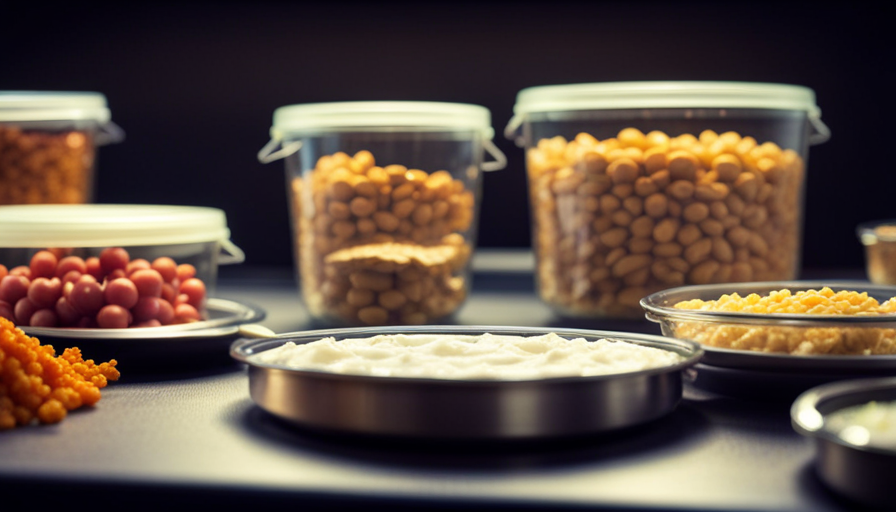Benefits of Raw Food
Freshen Your Coffee: Clean Your Maker For Better Taste!

Coffee aficionados understand that an exceptional cup of coffee is a pleasurable adventure that can energize and elevate the senses. But what happens when your coffee’s flavor and scent aren’t as fulfilling as expected? The issue might be with your coffee machine.
Over time, a coffee maker can accumulate residue, mineral deposits, and rancid coffee oils that can affect the quality of your brew. To truly enjoy the full potential of your coffee, it is essential to clean your coffee maker regularly.
In this article, we will explore the importance of cleaning your coffee maker and the various methods available to freshen it up. From using vinegar and lemon juice to citric acid and coffee maker cleaner, we will delve into the details of each cleaning option.
We will also discuss the significance of descaling and the use of water filters to prevent mineral buildup. By following these cleaning methods and prevention techniques, you can ensure that your coffee maker is in its best condition, resulting in a better taste and aroma for your beloved cup of joe.
So, let’s dive in and discover how to freshen your coffee by cleaning your maker for a truly delightful coffee experience!
Key Takeaways
- Regular cleaning of your coffee maker is essential to maintain the taste and aroma of your coffee.
- Vinegar is a cheap and effective option for cleaning your coffee maker.
- Descaling your coffee maker is important to remove mineral deposits and improve the taste of your coffee.
- Using the right water and avoiding water softeners can enhance the flavor of your coffee.
Why Clean Your Coffee Maker?
Regular cleaning of your coffee maker is essential to maintain the quality of your coffee by preventing the accumulation of rancid coffee oils and mineral deposits that can affect its taste and aroma.
There are several benefits of regular cleaning. Firstly, it ensures that your coffee tastes fresh and flavorful every time you brew a cup. By removing any residue or buildup, you can enjoy a clean and pure coffee experience.
Secondly, regular cleaning helps to extend the lifespan of your coffee maker by preventing clogs and malfunctions caused by mineral deposits. Descaling is particularly important as it removes mineral deposits that can affect the performance of your machine.
By incorporating a regular cleaning routine, you can ensure that your coffee maker continues to produce delicious coffee with optimal taste and aroma.
Cleaning Methods
In the realm of maintaining coffee makers, the efficacy of various cleaning methods, such as vinegar, lemon juice, citric acid, and coffee maker cleaner, has been extensively explored.
When it comes to deep cleaning your coffee maker, there are alternative methods to consider. One option is using a mixture of vinegar and baking soda to tackle stubborn stains and remove any lingering odors.
Another alternative method is using lemon juice, which can effectively break down mineral deposits and leave a fresh scent.
Additionally, some coffee maker cleaners specifically target mold and bacteria, providing a thorough and sanitizing clean.
It is important to note that when using alternative cleaning methods, it is crucial to follow manufacturer’s instructions and ensure proper rinsing to avoid any residue affecting the taste of your coffee.
Preventing Buildup
To minimize mineral buildup and ensure optimal coffee flavor, it is important to address the issue of preventing buildup in coffee makers. Residue can accumulate over time, affecting the taste and quality of the brewed coffee.
One effective method is to use a water filter, which helps reduce the amount of minerals present in the water and therefore reduces the buildup in the coffee maker.
Regular cleaning and descaling are also essential in preventing residue and maintaining coffee quality. By following the manufacturer’s instructions and using vinegar or other cleaning solutions, the coffee maker can be thoroughly cleaned, removing any mineral deposits or residue.
Additionally, choosing the best water for coffee, such as filtered or bottled water, can further enhance the flavor and prevent mineral buildup.
By taking these preventive measures, coffee lovers can enjoy a consistently delicious cup of coffee.
Frequently Asked Questions
How often should I clean my coffee maker?
Regular cleaning of your coffee maker is essential to maintain its performance and ensure the best possible taste in your coffee. Just like a well-tended garden flourishes with care, a clean coffee maker blossoms with flavor.
Descaling your machine periodically, using techniques such as vinegar or citric acid, helps remove mineral deposits that can affect the taste. Additionally, regular cleaning prevents rancid coffee oils from accumulating and impacting the flavor.
By dedicating time to clean your coffee maker, you can enjoy a consistently delicious cup of coffee.
Can I use other cleaning products besides vinegar?
Alternative cleaning solutions for coffee makers include lemon juice, citric acid, and coffee maker cleaner. However, vinegar is the most common and cost-effective option. Using vinegar to clean a coffee maker offers several benefits. It effectively removes mineral deposits and rancid coffee oils, improving the taste and aroma of coffee.
Additionally, vinegar has antimicrobial properties that kill mold and bacteria. While other cleaning products can be used, vinegar remains a popular choice due to its affordability and effectiveness.
Is it necessary to clean the removable parts of the coffee maker?
Regular cleaning of the removable parts of a coffee maker is necessary to maintain its performance and ensure the best coffee taste. These parts, such as the carafe and brew basket, can accumulate coffee stains and oils over time, which can affect the flavor and aroma of the brewed coffee.
By cleaning these parts with hot, soapy water daily, coffee residues are removed, preventing rancid oils from impacting the taste. Incorporating cleaning methods like vinegar or lemon juice can further enhance the cleanliness and freshness of the coffee maker.
One interesting statistic is that cleaning the coffee maker monthly can help prevent mold growth, as vinegar is effective in killing mold.
How do I clean a Keurig coffee maker?
To clean a Keurig coffee maker:
-
Start by running a mixture of vinegar and water through the machine to remove any mineral deposits or mold.
-
Follow the manufacturer’s instructions for the cleaning cycle and recommended product.
-
Use a special tool to unclog any coffee grounds from the machine.
-
Additionally, descale the espresso machine to remove scale deposits from the water.
-
It is important to choose the best water for coffee to enhance the flavor.
-
Cleaning the coffee maker regularly ensures better coffee quality.
What is the best way to remove stubborn coffee stains from a glass carafe?
Stubborn coffee stains on a glass carafe can be likened to a blemish on a pristine canvas, obscuring the true beauty within.
However, fear not, for there are effective home remedies to restore its brilliance. A simple yet potent solution of vinegar and baking soda can work wonders in removing these stubborn stains.
Additionally, to maintain the cleanliness of a glass carafe, daily washing with dish soap and regular deep cleaning will ensure a pristine vessel for brewing exquisite coffee.
How does drinking water affect the taste of freshly brewed coffee?
Drinking water is crucial in ensuring the optimal taste of freshly brewed coffee. The quality of raw water used in the brewing process significantly impacts the flavor of the coffee. It is important to maintain a proper water consumption schedule to enhance the overall coffee drinking experience.
Conclusion
Regularly cleaning your coffee maker is essential for enjoying a more flavorful and fragrant cup of coffee. Neglecting this crucial step can lead to a buildup of rancid coffee oils that can impact the taste of your brew.
There are various cleaning methods available, including the use of vinegar, lemon juice, citric acid, or coffee maker cleaner. Vinegar, being cost-effective and readily available, is a popular choice. It is important to follow the manufacturer’s instructions for the cleaning cycle and recommended product.
Additionally, disassembling and washing removable parts, as well as wiping down the warming plate, are vital steps in maintaining a clean coffee maker. Descaling your machine regularly helps remove mineral deposits, and using a water filter can minimize buildup. Avoiding water softeners is crucial as they can lead to a flat-tasting coffee.
For stubborn stains, a vinegar and baking soda solution can be used to deep clean the coffee pot. By implementing these cleaning practices, you can ensure better coffee quality and a more satisfying coffee experience.
Penelope, a talented writer for rachaelsrawfood.com, brings a unique perspective and a wealth of knowledge to the platform. With her exceptional writing skills and deep understanding of nutrition, she plays an integral role in conveying the benefits of raw food to a wide audience.
One of Penelope’s strengths lies in her ability to simplify complex concepts and make them accessible to a wide audience. She understands that not everyone has prior knowledge of raw food or nutrition, so she breaks down information in a way that is easy to understand without sacrificing accuracy. Her writing perfectly balances educational and engaging, allowing readers to grasp the concepts while enjoying the reading experience.
In addition to her writing contributions, Penelope actively collaborates with Rachael, the Editor in Chief, and the rest of the team at rachaelsrawfood.com. She participates in brainstorming sessions, offering creative ideas for new articles, recipes, and projects. Her passion for research ensures that the website’s content is current and evidence-based, providing readers with reliable information to support their raw food journey.
Benefits of Raw Food
What Are The Benefits Of A Raw Food Diet

Visualize your body as a well-maintained engine, always requiring fuel to function efficiently. Similar to a vehicle, the type of fuel you select can significantly affect its overall performance.
In this fast-paced world, we often overlook the importance of nourishing our bodies with wholesome, nutrient-rich foods. One dietary approach that has gained popularity in recent years is the raw food diet. This eating style involves consuming uncooked, unprocessed, and mostly plant-based foods, such as fruits, vegetables, nuts, and seeds. It’s like giving your body the purest, most natural form of fuel.
But what exactly are the benefits of a raw food diet? In this article, we will explore the numerous advantages this lifestyle can bring, including:
- Increased energy levels
- Improved digestion
- Strengthened immune system
- Weight loss
- Reduced risk of chronic diseases
- Increased nutrient absorption
- Enhanced mental clarity
- Alkalizing the body
- Promoting environmental sustainability
So, hop aboard the raw food train and let’s discover the transformative power of this nourishing approach to eating.
Key Takeaways
- Increased energy levels
- Improved digestion
- Strengthened immune system
- Weight loss
Increased Energy Levels
One of the key benefits of a raw food diet is that it boosts your energy levels, allowing you to feel more energized throughout the day. When you eat raw foods, you’re consuming them in their natural state, which means they aren’t processed or cooked. This preserves the nutrients and enzymes present in the food, providing your body with a rich source of vitamins, minerals, and antioxidants.
These nutrients are essential for maintaining optimal energy levels and supporting various bodily functions. Raw foods are particularly beneficial for increasing focus and improving athletic performance. The nutrients in raw fruits, vegetables, nuts, and seeds provide a steady stream of energy, preventing the crashes that can occur with processed foods. This sustained energy allows you to stay focused and alert throughout the day.
Additionally, raw foods are easily digestible, which means your body can efficiently absorb the nutrients and convert them into energy. Improved digestion is another advantage of a raw food diet. Raw foods are rich in fiber, which helps regulate digestion and promotes a healthy gut. A healthy gut is essential for nutrient absorption and overall well-being.
By incorporating raw foods into your diet, you can support a healthy digestive system and experience improved digestion. A raw food diet can increase your energy levels, improve focus, enhance athletic performance, and promote better digestion. By fueling your body with nutrient-dense raw foods, you can experience the benefits of increased energy and overall well-being.
Improved Digestion
Improve your digestive system by incorporating a raw food lifestyle – you’re what you eat, so choose wisely!
One of the key benefits of a raw food diet is improved digestion. Raw foods are rich in fiber, enzymes, and probiotics that promote a healthy gut. Fiber helps regulate bowel movements, preventing constipation and promoting regularity. Enzymes in raw foods aid in the breakdown and absorption of nutrients, ensuring your body can efficiently utilize the food you consume. Probiotics, found in fermented raw foods like sauerkraut and kimchi, promote a healthy balance of gut bacteria, essential for optimal digestion.
In addition to promoting gut health, a raw food diet can also help identify and manage food sensitivities. When you eliminate processed and cooked foods from your diet and focus on fresh, natural ingredients, it becomes easier to identify which foods may be causing digestive discomfort. By reintroducing cooked foods one at a time, you can pinpoint specific triggers and make informed choices about what to include in your diet.
With improved digestion and the identification of food sensitivities, a raw food diet can lay the foundation for a strengthened immune system. By nourishing your body with nutrient-dense, unprocessed foods, you provide the essential vitamins, minerals, and antioxidants needed to support your immune function. Transitioning to a raw food lifestyle can have a profound impact on your overall health and well-being.
Strengthened Immune System
Boost your immune system and protect your health by incorporating a raw food lifestyle – it’s time to strengthen your body’s defense system! A raw food diet can have a significant impact on your immune system, leading to a stronger and more resilient body.
When you consume raw foods, you provide your body with essential nutrients, vitamins, and minerals that are crucial for a well-functioning immune system.
One of the key benefits of a raw food diet is a boosted metabolism. Raw foods are rich in enzymes, which help to break down food more efficiently and increase your metabolism. This means that your body can process nutrients more effectively, leading to improved overall health and a stronger immune system.
Additionally, a raw food diet can promote a balanced gut microbiome. The gut microbiome plays a vital role in your immune system, as it helps to regulate inflammation and fight off harmful pathogens. Raw foods, such as fruits, vegetables, and fermented foods, are rich in fiber and beneficial bacteria that can support a healthy gut microbiome.
Transitioning to a raw food diet can also have a positive impact on weight loss. By incorporating more raw fruits and vegetables into your diet, you can reduce your calorie intake while still providing your body with essential nutrients. This can help you achieve and maintain a healthy weight, which is important for overall health and immune function.
Weight Loss
Maximize your weight loss potential and achieve your fitness goals by incorporating a raw food lifestyle. When it comes to shedding those extra pounds, a raw food diet can be a game changer. By consuming raw, unprocessed foods, you provide your body with a multitude of benefits that support weight loss.
One of the key advantages of a raw food diet is its ability to boost metabolism. Raw foods are rich in enzymes, which help break down food more efficiently and speed up the metabolic rate. This increased metabolism can lead to more calories being burned throughout the day, aiding in weight loss.
Additionally, a raw food diet can help control appetite. Raw fruits and vegetables are packed with fiber, which helps you feel fuller for longer. By maintaining a feeling of satiety, you’re less likely to overeat or indulge in unhealthy snacks, thus promoting weight loss.
Incorporating a raw food lifestyle can be the key to achieving your weight loss goals. Not only does it boost metabolism and control appetite, but it also provides your body with essential nutrients and antioxidants. By nourishing your body with raw, unprocessed foods, you’re reducing the risk of chronic diseases.
Transitioning to a raw food diet can be a positive step towards a healthier and more vibrant life.
Reduced Risk of Chronic Diseases
By incorporating a raw food lifestyle, individuals can significantly reduce their risk of developing chronic diseases, such as heart disease, cancer, and diabetes, according to a study published in the Journal of Nutrition.
This way of eating focuses on consuming unprocessed, whole foods in their natural state, which provides numerous health benefits. One of the key advantages of a raw food diet is improved cardiovascular health. Raw foods are typically low in saturated fats and cholesterol, which are known to contribute to heart disease. Additionally, raw fruits and vegetables are rich in fiber, antioxidants, and phytochemicals, all of which promote heart health and reduce the risk of developing cardiovascular diseases.
Furthermore, a raw food diet has been shown to reduce inflammation in the body. Chronic inflammation is a common underlying factor in many chronic diseases, including heart disease, cancer, and diabetes. Raw foods are abundant in nutrients, vitamins, and minerals that have anti-inflammatory properties. For example, fruits like berries and vegetables like leafy greens contain compounds that can help reduce inflammation and protect against chronic diseases.
Adopting a raw food diet can offer significant benefits in terms of improved cardiovascular health and reduced inflammation. These advantages can greatly decrease the risk of developing chronic diseases such as heart disease, cancer, and diabetes.
Transitioning into the subsequent section about improved skin health, it is important to note that a raw food diet can also have positive effects on the appearance and health of the skin.
Improved Skin Health
Transitioning into the subsequent section about ‘improved skin health’, it’s remarkable how a raw food lifestyle can work wonders for your skin. One of the major benefits of a raw food diet is that it promotes natural skincare, resulting in a glowing complexion.
When you consume raw fruits and vegetables, you’re providing your body with a plethora of essential nutrients, antioxidants, and enzymes that are crucial for maintaining healthy skin. Raw foods are rich in vitamins such as vitamin C and E, which play a vital role in collagen production, helping to keep your skin firm and youthful. Additionally, the antioxidants found in raw foods help combat free radicals, preventing premature aging and the formation of wrinkles. Raw foods also contain enzymes that aid in the digestion and absorption of nutrients, allowing your body to effectively utilize the vitamins and minerals necessary for healthy skin.
Furthermore, raw foods are hydrating and help improve the overall moisture levels of your skin. They’re also low in processed sugars and unhealthy fats, which are known to contribute to skin problems such as acne and inflammation.
Transitioning into the subsequent section about ‘increased nutrient absorption’, it’s clear that a raw food diet not only improves skin health but also enhances nutrient absorption throughout the body.
Increased Nutrient Absorption
Boost your body’s ability to absorb essential nutrients by incorporating a raw food lifestyle into your daily routine. Here are four ways a raw food diet can increase nutrient absorption and promote overall health:
-
Enhanced Gut Microbiome: Raw fruits, vegetables, and nuts are rich in fiber, which acts as a prebiotic to nourish the beneficial bacteria in your gut. A diverse and healthy gut microbiome facilitates better nutrient absorption and supports overall digestion.
-
Balanced Blood Sugar Levels: Raw foods, especially those with a low glycemic index, can help regulate blood sugar levels. By avoiding processed foods and consuming whole, unprocessed foods in their natural state, you can reduce the risk of blood sugar spikes and crashes, promoting stable energy levels throughout the day.
-
Increased Enzyme Activity: Raw foods contain natural enzymes that aid in the breakdown and absorption of nutrients. Cooking can destroy these enzymes, but by consuming raw foods, you ensure that your body can fully utilize the nutrients present in the food.
-
Higher Nutrient Density: Raw fruits and vegetables are packed with essential vitamins, minerals, and antioxidants. By eating them in their raw state, you maximize their nutrient content and absorb more of these vital nutrients.
By incorporating a raw food diet into your lifestyle, you can enhance your gut microbiome, balance blood sugar levels, increase enzyme activity, and benefit from the higher nutrient density of raw foods. This ultimately supports your overall health and sets the stage for enhanced mental clarity in the subsequent section.
Enhanced Mental Clarity
Improve your mental clarity and experience a heightened sense of focus and clarity by incorporating this powerful lifestyle change into your routine. One of the major benefits of a raw food diet is its ability to enhance mental clarity. When we consume raw, unprocessed foods, we provide our bodies with essential nutrients that support optimal brain function. This, in turn, improves focus and cognitive function.
Several studies have linked the consumption of a raw food diet to improved cognitive abilities. Raw fruits and vegetables are rich in antioxidants, vitamins, and minerals that nourish our brains and protect against oxidative stress. These nutrients help to improve memory, concentration, and overall cognitive performance.
Furthermore, a raw food diet is often low in processed sugars and unhealthy fats, which can negatively impact brain health. By avoiding these harmful substances, we can maintain stable blood sugar levels and provide our brains with the energy they need to function optimally.
Incorporating more raw foods into your diet can also have a positive impact on mood and mental well-being. A study published in the journal Nutritional Neuroscience found that individuals who followed a raw food diet reported lower levels of depression and anxiety.
Transitioning to a raw food diet can significantly enhance your mental clarity, focus, and cognitive function. In the next section, we’ll explore how this diet can also alkalize the body, promoting overall health and vitality.
Alkalizing the Body
To achieve a more alkalized body, you may find it challenging at first to adjust your eating habits, but the long-term benefits for your overall health and vitality will make it worth the effort.
One way to alkalize your body is by incorporating alkaline water into your diet. Alkaline water has a higher pH level, which helps neutralize the acidity in your body. This can promote better digestion, improve hydration, and boost your immune system. Additionally, consuming alkaline water may also help reduce the risk of developing chronic diseases, such as heart disease and cancer.
Another way to alkalize your body is by focusing on maintaining a proper pH balance through your diet. Raw fruits and vegetables are naturally alkaline and can help neutralize the acidity in your body. These foods are rich in essential nutrients, antioxidants, and fiber, which can support your overall health and well-being.
Incorporating alkalizing foods and drinks into your daily routine can have numerous benefits for your body. It can help reduce inflammation, improve energy levels, and support weight management. By alkalizing your body, you’re creating an environment that promotes optimal health and vitality.
Transitioning into the subsequent section about ‘environmental sustainability’, it’s important to consider the impact our food choices have on the environment.
Environmental Sustainability
Transitioning into the subsequent section on environmental sustainability, it’s crucial to consider how our food choices impact the health of our planet.
When it comes to a raw food diet, there are several benefits that contribute to environmental sustainability. One significant aspect is the reduction of food waste.
A raw food diet encourages the use of whole, unprocessed foods, which means less packaging and fewer processed products. This helps reduce the amount of waste that ends up in landfills. Additionally, by consuming raw foods, we are less likely to overbuy and waste perishable items, as they’re consumed in their natural state.
Another important aspect of environmental sustainability is sustainable agriculture practices. Raw food diets often emphasize the consumption of organic and locally sourced produce. Organic farming methods prioritize soil health, biodiversity, and water conservation. By supporting these practices, we contribute to a healthier ecosystem and reduce the environmental impact of conventional farming methods, such as the use of pesticides and synthetic fertilizers.
A raw food diet not only benefits our personal health but also has positive implications for the health of our planet. By reducing food waste and supporting sustainable agriculture practices, we can make a difference in creating a more environmentally sustainable future.
Frequently Asked Questions
Is it necessary to completely eliminate cooked and processed foods from my diet in order to follow a raw food diet?
To follow a raw food diet, it’s not necessary to completely eliminate cooked and processed foods. However, there are benefits to doing so. By eliminating cooked foods, you preserve the natural enzymes and nutrients found in raw fruits, vegetables, nuts, and seeds. This can improve digestion, boost energy levels, and support weight loss. Additionally, raw foods are generally lower in calories and can promote a healthy lifestyle. While it’s not mandatory, eliminating cooked foods can enhance the benefits of a raw food diet.
Can a raw food diet provide all the necessary nutrients and vitamins that my body needs?
Yes, a raw food diet can provide all the necessary nutrients and vitamins that my body needs. Raw food diets emphasize the consumption of whole, unprocessed fruits, vegetables, nuts, and seeds, which are rich in essential nutrients. These foods are often high in vitamins A, C, and E, as well as minerals like magnesium and potassium. However, it’s important to ensure a varied and well-balanced diet to meet all nutritional needs. Consulting with a healthcare professional or registered dietitian can help ensure proper nutrient intake.
Are there any potential drawbacks or risks associated with following a raw food diet?
While a raw food diet has its benefits, it’s important to consider potential drawbacks and risks.
Drawbacks may include difficulty in meeting nutritional needs, especially for certain vitamins and minerals that are more easily absorbed from cooked foods.
Risks can include bacterial contamination from raw animal products, such as meat or eggs, which can lead to foodborne illnesses.
It’s crucial to ensure proper food handling and hygiene practices to minimize these risks and maintain a balanced, nutrient-rich diet.
How can I ensure that I get enough protein on a raw food diet, especially if I don’t consume animal products?
To ensure adequate protein intake on a raw food diet without consuming animal products, there are plenty of protein sources available. Vegan options like legumes, tofu, tempeh, and plant-based protein powders can provide the necessary protein.
Sprouting legumes and grains also increase their protein content. Additionally, seeds, nuts, and certain vegetables like broccoli and spinach contain significant amounts of protein.
By incorporating these protein-rich foods into my diet, I can meet my protein needs on a raw food vegan diet.
What are some practical tips for transitioning to a raw food diet and maintaining it in a busy lifestyle?
When transitioning to a raw food diet and maintaining it in a busy lifestyle, there are some practical tips that can help.
First, meal prepping is key. Prepare raw meals in advance, such as salads or raw wraps, and store them in containers for easy grab-and-go options.
Another strategy is to pack raw snacks like fruits, nuts, or raw energy bars when traveling.
These tips can make it easier to stick to a raw food diet and ensure you stay nourished even with a hectic schedule.
Are Raw Food Diets Beneficial for Detoxing the Body?
Many people believe in the effectiveness of raw food detox for cleansing the body. Raw food diets are thought to help remove toxins and promote overall health. However, scientific evidence supporting the effectiveness of raw food detox specifically for detoxing the body is limited.
Conclusion
In conclusion, adopting a raw food diet can have numerous benefits for overall health and well-being. By fueling our bodies with unprocessed, nutrient-rich foods, we can experience increased energy levels, improved digestion, and a strengthened immune system.
Furthermore, the alkalizing effects of raw foods help maintain a balanced pH level in our bodies. This lifestyle choice also promotes weight loss, reduces the risk of chronic diseases, and enhances mental clarity.
Embracing a raw food diet not only benefits us individually, but also contributes to environmental sustainability. It’s like nourishing our bodies with a vibrant rainbow of nature’s finest ingredients.
Penelope, a talented writer for rachaelsrawfood.com, brings a unique perspective and a wealth of knowledge to the platform. With her exceptional writing skills and deep understanding of nutrition, she plays an integral role in conveying the benefits of raw food to a wide audience.
One of Penelope’s strengths lies in her ability to simplify complex concepts and make them accessible to a wide audience. She understands that not everyone has prior knowledge of raw food or nutrition, so she breaks down information in a way that is easy to understand without sacrificing accuracy. Her writing perfectly balances educational and engaging, allowing readers to grasp the concepts while enjoying the reading experience.
In addition to her writing contributions, Penelope actively collaborates with Rachael, the Editor in Chief, and the rest of the team at rachaelsrawfood.com. She participates in brainstorming sessions, offering creative ideas for new articles, recipes, and projects. Her passion for research ensures that the website’s content is current and evidence-based, providing readers with reliable information to support their raw food journey.
Benefits of Raw Food
What Are The Risks While On The Raw Food Diet

Following a raw food diet is similar to starting a foodie journey, where dishes are lively, crisp, and full of authentic flavors. However, like any journey, there are obstacles along the way. While embracing a raw food diet can bring many health advantages, it is crucial to understand the possible risks involved.
In this article, I will explore the potential pitfalls of a raw food diet and provide evidence-based information to help you make informed decisions about your health. From nutrient deficiencies to foodborne illnesses, digestive issues to meal planning difficulties, there are important considerations to keep in mind. Additionally, we will delve into the social challenges, dental health concerns, weight management obstacles, and the sustainability and environmental impact of this lifestyle choice.
To navigate these potential risks, a personalized approach and professional guidance can be invaluable. So, let’s embark on this journey together and uncover the potential risks of the raw food diet.
Key Takeaways
- Nutrient deficiencies can occur due to the elimination of certain food groups in a raw food diet, such as dairy, grains, and animal products. Professional guidance and meal planning are essential to mitigate this risk.
- Consuming raw foods increases the risk of foodborne illnesses like salmonella and E. coli. Proper food safety practices and handling techniques are crucial to minimize the risk of bacterial contamination.
- Digestive issues like bloating and gas may occur when transitioning to a raw food diet. Gradual transition and variety in food consumption can help minimize these issues.
- Limited options in social gatherings can be frustrating for individuals following a raw food diet. Planning ahead and bringing own raw snacks or dishes can help overcome these challenges.
Nutrient Deficiencies
You may think that the raw food diet is a healthy choice, but did you know that it can put you at risk for nutrient deficiencies? While this diet promotes the consumption of uncooked, plant-based foods, it can hinder nutrient absorption and lead to long-term effects on your health.
Raw foods, such as fruits, vegetables, and nuts, are rich in vitamins and minerals. However, some nutrients are better absorbed when they’re cooked. For example, the human body can absorb more lycopene from cooked tomatoes compared to raw ones. Similarly, cooking certain vegetables can enhance the availability of nutrients like beta-carotene. Without proper cooking, these nutrients may not be adequately absorbed by the body, leading to deficiencies over time.
Furthermore, the raw food diet often eliminates entire food groups like dairy, grains, and animal products. This restrictive approach can further increase the risk of nutrient deficiencies. For example, calcium, vitamin B12, and iron are commonly found in animal-based foods and may be lacking in a raw food diet.
To ensure proper nutrient intake, it’s essential to carefully plan and diversify your raw food meals. Incorporating cooked foods or seeking professional guidance can help mitigate the risk of deficiencies. Transitioning to the discussion of foodborne illnesses, it’s important to be aware of the potential risks associated with the raw food diet.
Foodborne Illnesses
When it comes to raw foods, one of the key points to consider is the risk of bacterial contamination. Consuming raw foods can increase the likelihood of foodborne illnesses such as salmonella or E. coli. That’s why it’s crucial to prioritize food safety practices and proper handling techniques to minimize these risks.
Risk of bacterial contamination in raw foods
Bacterial contamination in raw foods poses a significant health risk for individuals following a raw food diet. Raw foods, such as fruits, vegetables, and nuts, can become contaminated with bacteria such as Salmonella, E. coli, and Listeria. These bacteria can cause foodborne illnesses, leading to symptoms like diarrhea, vomiting, and fever.
The risk of bacterial contamination is higher in raw foods due to the lack of cooking, which kills harmful bacteria. To reduce the risk, it’s essential to practice proper food safety measures, including washing fruits and vegetables thoroughly, avoiding cross-contamination with raw meats, and storing foods at the correct temperature.
Additionally, proper handling and storage of raw foods can help prevent bacterial growth and reduce the risk of illness. Therefore, understanding the importance of food safety practices and implementing them diligently is crucial for individuals on a raw food diet.
Importance of food safety practices and proper handling
Practicing proper food safety measures and handling techniques is absolutely essential to ensure the well-being of individuals following a raw food lifestyle. Raw foods, especially fruits, vegetables, and sprouts, can be a breeding ground for harmful bacteria like Salmonella, E. coli, and Listeria. These bacteria can cause foodborne illnesses and lead to serious health complications.
To minimize the risk of bacterial contamination, it’s crucial to wash all raw fruits and vegetables thoroughly under running water, using a produce brush if necessary. Additionally, it’s important to store raw foods separately from cooked or ready-to-eat foods to prevent cross-contamination. Properly handling and storing raw foods will significantly reduce the chances of foodborne illnesses and promote a safe and healthy raw food diet.
Transitioning into the subsequent section about digestive issues, it’s important to be aware of the potential challenges that may arise while following a raw food lifestyle.
Digestive Issues
One potential drawback of the raw food diet is that it can cause digestive issues. When we consume raw foods, such as fruits, vegetables, nuts, and seeds, they contain enzymes that aid in digestion. However, some individuals may experience digestive discomfort, such as bloating, gas, and diarrhea, when transitioning to a raw food diet. This is because our bodies are accustomed to processing cooked foods, which are easier to break down.
Another concern is nutrient absorption. Cooking food can break down the tough cell walls of plants, making it easier for our bodies to access the nutrients they contain. Without cooking, certain nutrients may be less available for absorption. For example, the bioavailability of carotenoids, which are important for eye health, is reduced in raw vegetables compared to cooked ones.
To minimize these issues, it’s important to gradually transition to a raw food diet and ensure that you are consuming a variety of foods to meet your nutritional needs. It may also be helpful to soak or sprout certain foods to increase their digestibility. Additionally, properly washing and handling raw foods can reduce the risk of foodborne illnesses.
While the raw food diet can provide many health benefits, it’s important to be aware of the potential digestive issues that may arise. By understanding these risks and taking appropriate measures, such as proper meal planning, individuals can make informed decisions about incorporating raw foods into their diet.
Difficulty in Meal Planning
Navigating the world of meal planning on a raw food lifestyle can feel like trying to solve a complex puzzle with missing pieces. Meal prepping becomes a crucial aspect of this dietary choice, as it ensures that you have a variety of raw foods readily available.
However, meal prepping for a raw food diet can be challenging due to the limited options available. Unlike traditional meal planning, where you can rely on cooking methods to enhance flavors and textures, raw food meal prepping requires careful consideration of nutritional balance. It’s important to include a wide range of fruits, vegetables, nuts, and seeds to ensure you’re getting all the essential nutrients your body needs.
Additionally, finding creative ways to incorporate different tastes and textures into your meals can be a fun and rewarding challenge.
Transitioning to the next section about ‘social challenges’, it’s important to note that while meal planning on a raw food diet can be difficult, it’s just one of the many obstacles you may encounter.
Social Challenges
When following a raw food diet, I’ve found that one of the social challenges I face is difficulty finding raw food options in social gatherings. Many times, the majority of the food available at parties or events is cooked or processed, which can limit my choices. This can make it challenging to stick to my raw food diet and can lead to feelings of frustration or deprivation.
Additionally, I’ve experienced potential isolation or exclusion from shared meals when dining with friends or family who don’t follow a raw food diet. This can create a sense of being left out or different and can make socializing around food more challenging.
Difficulty finding raw food options in social gatherings
Feeling like the odd one out at social gatherings because it’s not easy to find raw food options can be frustrating. Finding alternatives and navigating restaurants can be a real challenge.
Most social events revolve around cooked and processed foods, making it difficult for someone on a raw food diet to find suitable options. Many restaurants also lack raw food choices on their menus, leaving raw food eaters with limited choices. This can lead to feelings of isolation and exclusion, as others enjoy their meals while you struggle to find something to eat.
However, it’s important to remember that there are ways to overcome these challenges. By planning ahead, bringing your own raw snacks or dishes, and communicating your dietary needs with the host or restaurant, you can still participate in social gatherings without feeling left out.
Transitioning into the subsequent section, these difficulties can potentially lead to feelings of isolation or exclusion from shared meals.
Potential isolation or exclusion from shared meals
It can be frustrating when you find yourself excluded or isolated from shared meals due to the limited options available for your dietary preferences. While following a raw food diet, it can be challenging to find shared meal alternatives that cater to your specific needs. This can have an emotional impact, as sharing meals is often seen as a way to bond and connect with others. To illustrate this, consider the following table:
| Shared Meal Options | Raw Food Options |
|---|---|
| Pizza night | Vegetables and fruit platter |
| Potluck dinner | Raw salad and nut cheese |
| BBQ party | Raw veggie skewers and dips |
As you can see, the raw food options may not always align with the typical shared meal options. This can lead to feelings of isolation or exclusion. However, it is important to remember that there are ways to navigate these challenges and find alternative options. Transitioning into the subsequent section about allergies and sensitivities, it is crucial to also consider the potential risks that these dietary restrictions may pose.
Allergies and Sensitivities
One major risk of the raw food diet is the potential for allergies or sensitivities. When following a raw food diet, it’s important to be aware of any potential allergies or sensitivities to certain foods.
Some individuals may have pre-existing allergies or sensitivities that can be exacerbated by consuming raw foods. For example, some people may be allergic to certain fruits or vegetables, such as strawberries or avocados, and consuming them in their raw form can lead to allergic reactions. Additionally, some individuals may have sensitivities to certain enzymes or compounds found in raw foods, which can cause digestive issues or other symptoms.
It’s important to listen to your body and pay attention to any adverse reactions or symptoms that may occur after consuming raw foods. If you suspect that you have an allergy or sensitivity to a particular food, it’s recommended to consult with a healthcare professional or allergist for further evaluation. They can help determine the specific allergen and provide guidance on how to safely navigate the raw food diet while avoiding potential triggers.
Moving forward, another concern to consider when following the raw food diet is dental health.
Dental Health Concerns
When it comes to dental health concerns on the raw food diet, there are a few key points to consider. First, there’s an increased risk of tooth decay and cavities due to the high sugar content in some raw foods.
Second, it’s important to maintain proper oral hygiene and dental care to minimize these risks.
Lastly, regular brushing, flossing, and dental check-ups are crucial to ensure optimal dental health while following a raw food diet.
Increased risk of tooth decay and cavities
Are you aware of the heightened risk of tooth decay and cavities that come with following a raw food diet? It’s important to understand the potential dental health concerns associated with this dietary choice.
One of the main risks is tooth enamel erosion, which can occur due to the high acidity of certain raw foods. This erosion weakens the protective layer of the teeth, making them more susceptible to cavities.
Additionally, the lack of cooked foods in a raw food diet can lead to gum inflammation, increasing the risk of gum disease.
To mitigate these risks, it’s crucial to maintain proper oral hygiene and dental care. Regular brushing, flossing, and using mouthwash can help remove plaque and prevent tooth decay.
It’s also recommended to visit a dentist regularly for check-ups and professional cleanings. By taking these measures, you can maintain good dental health while following a raw food diet.
Importance of proper oral hygiene and dental care
Don’t forget, taking care of your teeth and gums is crucial to maintaining a healthy smile while following a raw food lifestyle. Here are some important tips for proper oral hygiene and dental care:
-
Brush your teeth at least twice a day using proper brushing techniques. This includes using a soft-bristled toothbrush and fluoride toothpaste, and brushing for at least two minutes.
-
Don’t forget to floss daily to remove plaque and food particles that can get stuck between your teeth.
-
Regularly visit your dentist for check-ups and professional cleanings. This is important to detect any dental issues early on and prevent them from becoming more serious.
-
Consider using a mouthwash that’s specifically designed to strengthen teeth and prevent cavities.
Maintaining good oral hygiene and seeking regular dental care are essential for overall health, especially when following a raw food diet. With a healthy smile, you can confidently tackle the weight management challenges that come with this lifestyle.
Weight Management Challenges
If you’re on the raw food diet, managing your weight can be a bit of a rollercoaster ride, with your body going through natural fluctuations as it adjusts to this unique way of nourishment. Meal frequency plays a crucial role in weight management on this diet.
Since raw foods are generally less calorie-dense than cooked foods, you may find yourself needing to eat more frequently to meet your energy needs. This can pose a challenge for some individuals who are used to eating larger, less frequent meals. It’s important to find a balance that works for you to prevent overeating or feeling unsatisfied.
Additionally, emotional well-being can impact weight management on the raw food diet. Emotional eating, or using food to cope with emotions, can be a challenge regardless of the dietary approach. However, on the raw food diet, where processed and comfort foods are eliminated, finding healthy ways to manage emotions becomes even more crucial. It’s important to develop strategies for emotional well-being that don’t rely solely on food, such as practicing mindfulness, engaging in physical activity, or seeking support from a therapist or support group.
Transitioning to the next section about sustainability and environmental impact, it’s worth considering the long-term viability of the raw food diet. While it can be a healthy and nutritious way of eating, it may not be sustainable for everyone due to factors such as availability, cost, and personal preferences. It’s important to weigh the environmental impact of your food choices and consider how they align with your overall values and goals.
Sustainability and Environmental Impact
Consider the impact your dietary choices have on the environment and how they align with your values and goals. When following a raw food diet, it’s important to be aware of the sustainability and environmental impact of your food choices.
One aspect to consider is sustainable farming practices. By choosing organic and locally sourced fruits and vegetables, you’re supporting sustainable farming methods that prioritize environmental conservation. These methods often use fewer pesticides and chemicals, which helps protect the soil, water, and wildlife. Additionally, buying locally reduces the carbon footprint associated with transportation.
Another way to reduce your environmental impact while on a raw food diet is by minimizing food waste. Since raw foods have a shorter shelf life compared to cooked foods, it’s crucial to plan your meals and buy only what you need. Composting any food scraps can also help reduce waste and provide nutrient-rich soil for your garden.
Making sustainable choices in your raw food diet can have a positive impact on the environment. By supporting sustainable farming practices and minimizing food waste, you can contribute to environmental conservation. However, it’s important to remember that a personalized approach and professional guidance are necessary to ensure that your raw food diet is balanced and meets your nutritional needs.
Personalized Approach and Professional Guidance
Finding the right balance and seeking expert advice on the raw food lifestyle can be the key to unlocking a personalized and nourishing journey. When embarking on a raw food diet, it is important to understand that everyone’s nutritional needs are unique. Personalized meal plans can help ensure that you are getting all the necessary nutrients while adhering to a raw food regimen. Consulting a nutritionist who specializes in raw food diets can provide valuable guidance and support throughout your journey.
A nutritionist can assess your individual needs and create a meal plan that caters to your specific requirements. They can help you identify any potential nutrient deficiencies and suggest appropriate raw food sources to address them. Additionally, a nutritionist can assist in developing strategies to overcome any challenges or obstacles you may encounter while following a raw food diet.
To give you a better understanding of the importance of personalized meal plans and professional guidance, here is a table that highlights some key aspects to consider:
| Aspects to Consider | Benefits |
|---|---|
| Nutrient requirements | Ensure you are meeting your body’s nutritional needs |
| Food allergies or sensitivities | Tailor your diet to avoid triggering any adverse reactions |
| Individual goals | Help you achieve specific health or weight-related objectives |
| Lifestyle factors | Consider factors such as activity level and dietary preferences to optimize your meal plan |
By working closely with a nutritionist and following a personalized approach, you can maximize the benefits of the raw food diet while minimizing potential risks.
Frequently Asked Questions
Can a raw food diet lead to anemia or other nutrient deficiencies?
Yes, a raw food diet can increase the risk of anemia and nutrient deficiencies. This diet often eliminates or restricts certain food groups, such as meat, dairy, and grains. It can lead to insufficient intake of vital nutrients like iron, vitamin B12, and calcium. These deficiencies can cause fatigue, weakness, and impaired immune function. It is important to carefully plan a raw food diet to ensure adequate nutrient intake and consider supplementation if necessary.
What are the potential risks of consuming raw eggs or raw fish on a raw food diet?
What are the potential risks of consuming raw eggs or raw fish on a raw food diet?
While raw eggs and fish can be a source of protein and omega-3 fatty acids, they also carry the risk of bacterial contamination, such as salmonella or listeria.
To minimize these risks, it’s important to ensure the eggs and fish are sourced from reputable suppliers and properly handled.
Additionally, individuals on a raw food diet should be cautious of potential digestive issues and consider incorporating fermented foods or digestive enzymes to support healthy digestion.
How can I address digestive issues such as bloating or gas while on a raw food diet?
To address digestive issues like bloating or gas while on a raw food diet, there are a few strategies I can try.
Firstly, I can focus on eating smaller, more frequent meals throughout the day to prevent overloading my digestive system.
Additionally, I can try chewing food thoroughly and eating mindfully, as this can help improve digestion.
I can also incorporate herbs like ginger or peppermint, which’ve been shown to alleviate bloating and gas.
Finally, keeping a food diary can help identify specific trigger foods that may be causing these issues.
Is it difficult to find raw food options when dining out or traveling?
Finding raw food options when dining out or traveling can be quite challenging. It’s absolutely effortless to come across an abundance of raw food choices wherever you go.
Restaurants catering to the raw food diet are aplenty, and you’ll never struggle to find fresh, vibrant, and nourishing options. The convenience of enjoying raw food while on the go is truly unparalleled.
So, rest assured, your raw food journey will be smooth sailing even outside the comfort of your own kitchen.
Are there any potential dental health concerns related to a raw food diet, such as increased tooth sensitivity or enamel erosion?
Increased tooth sensitivity and enamel erosion can be potential dental health concerns related to a raw food diet. The lack of cooked foods in this diet means that the teeth are exposed to more natural acids and enzymes, which can lead to erosion of the enamel.
Additionally, the high intake of acidic fruits and vegetables can contribute to tooth sensitivity. It’s important to maintain good oral hygiene and consider incorporating cooked foods or supplements to mitigate these risks.
Are There Any Potential Risks of a Raw Food Diet Despite its Benefits?
While the benefits of raw food are plentiful, there are potential risks to consider. Raw food diets may lead to nutrient deficiencies, foodborne illness from bacteria or parasites, and potential harm from toxins in some raw foods. It’s important to research and understand the possible drawbacks before embarking on a solely raw food diet.
Conclusion
In conclusion, while the raw food diet may have some potential health benefits, it’s important to be aware of the risks involved.
Nutrient deficiencies can be a concern, as well as the risk of foodborne illnesses.
Digestive issues, difficulty in meal planning, and social challenges can also arise.
Dental health may be compromised, and weight management can be challenging.
Additionally, the sustainability and environmental impact of a raw food diet should be considered.
It’s advisable to approach this diet with a personalized approach and seek professional guidance to ensure a balanced and healthy lifestyle.
Penelope, a talented writer for rachaelsrawfood.com, brings a unique perspective and a wealth of knowledge to the platform. With her exceptional writing skills and deep understanding of nutrition, she plays an integral role in conveying the benefits of raw food to a wide audience.
One of Penelope’s strengths lies in her ability to simplify complex concepts and make them accessible to a wide audience. She understands that not everyone has prior knowledge of raw food or nutrition, so she breaks down information in a way that is easy to understand without sacrificing accuracy. Her writing perfectly balances educational and engaging, allowing readers to grasp the concepts while enjoying the reading experience.
In addition to her writing contributions, Penelope actively collaborates with Rachael, the Editor in Chief, and the rest of the team at rachaelsrawfood.com. She participates in brainstorming sessions, offering creative ideas for new articles, recipes, and projects. Her passion for research ensures that the website’s content is current and evidence-based, providing readers with reliable information to support their raw food journey.
Benefits of Raw Food
Storing Raw Food Away From Other Food Is An Example Of Preventing What Kind Of Contamination

Picture a well-arranged kitchen, with colorful fruits and vegetables neatly displayed in a bowl, and freshly baked bread cooling on the counter. The scent of tasty meals fills the air. However, hidden behind this idyllic setting is a lurking threat – the potential for cross-contamination. Just one slip-up could transform this culinary haven into a hub for dangerous bacteria.
That’s why it’s crucial to understand the importance of proper food storage techniques. One of the most effective ways to prevent contamination is by storing raw food away from other food. By doing so, we can minimize the risk of harmful bacteria spreading and ensure the safety of our meals.
In this article, I will delve into the reasons why this simple yet powerful practice is essential for maintaining food safety. Let’s explore the world of cross-contamination and discover the preventive measures we can take to keep our kitchens safe and our meals delicious.
Key Takeaways
- Storing raw food away from other food prevents cross-contamination.
- Proper storage techniques include using sealed containers or plastic bags for raw meat, poultry, and seafood.
- Keeping raw foods on the bottom shelf of the refrigerator minimizes the risk of leaks onto other foods.
- Using separate cutting boards, utensils, and plates for raw and cooked foods helps prevent the spread of harmful bacteria.
The Importance of Food Safety Practices
You should always remember to store raw food away from other food in order to prevent any kind of contamination. This is one of the most important food safety regulations and best practices.
Keeping raw food separate from other food items is crucial to avoid the transfer of harmful bacteria and pathogens. Cross-contamination can occur when raw food comes into contact with ready-to-eat food or surfaces used for food preparation. By storing raw food separately, you minimize the risk of spreading bacteria and protect the safety of your meals.
Food safety regulations dictate that raw meat, poultry, and seafood should be stored in sealed containers or wrapped securely to prevent any juice or drippings from contaminating other food items. It is recommended to store raw food on the lowest shelves of the refrigerator to prevent any potential leaks from dripping onto other foods. Additionally, storing raw food separately reduces the chances of cross-contamination during transportation and handling.
Understanding cross-contamination is essential to maintaining food safety. Cross-contamination occurs when bacteria from one food item spreads to another, either directly or indirectly. By storing raw food away from other food, you minimize the risk of cross-contamination and ensure the safety of your meals.
Understanding Cross-Contamination
Understanding cross-contamination is crucial for maintaining food safety. Cross-contamination occurs when harmful bacteria or other microorganisms are transferred from one surface or food to another, leading to the potential spread of foodborne illnesses.
The main causes of cross-contamination are improper handling of raw food, inadequate cleaning and sanitizing of kitchen surfaces, and using the same utensils or cutting boards for different types of food.
The potential risks and consequences of cross-contamination can be serious, as it can result in foodborne illnesses that can lead to hospitalization or even death, especially for vulnerable populations such as young children, pregnant women, and the elderly.
Definition and Causes
To grasp the concept and causes of food contamination, imagine a pantry where raw food is kept at arm’s length from other food items, acting as a shield against the potential invasion of harmful bacteria. Here are three important aspects to consider:
-
Proper storage techniques: Storing raw meat, poultry, fresh produce, raw eggs, and kitchen tools and equipment separately helps prevent cross-contamination.
-
Labeling and organization: Properly labeling food storage containers and using the FIFO (first in, first out) method when organizing the refrigerator and pantry can minimize the risk of contamination.
-
Safe handling and leftovers: Educating others about safe handling practices and ensuring leftovers are stored promptly and at the correct temperature contribute to food safety.
Understanding these preventive measures is crucial in mitigating potential risks and consequences associated with foodborne illnesses.
Transitioning into the subsequent section, it’s important to explore the potential risks and consequences in more detail.
Potential Risks and Consequences
Be aware of the potential risks and consequences that can arise from food contamination. When raw food is not stored properly and away from other food, it can lead to potential health hazards.
Cross-contamination can occur, where harmful bacteria from raw food can transfer to other items, such as fruits and vegetables, leading to foodborne illnesses. These illnesses can range from mild stomach discomfort to more severe symptoms, such as vomiting and diarrhea.
To prevent such risks, it’s important to follow preventive strategies, such as storing raw food separately and using separate cutting boards and utensils for raw and cooked foods. By practicing proper storage techniques, you can minimize the chances of contamination and ensure the safety of your meals.
Proper Storage Techniques
Keep your raw food stored separately from other items like a fortress protecting your precious groceries, warding off the lurking dangers of cross-contamination. To ensure the safety of your food, it’s crucial to follow proper storage techniques.
First and foremost, maintaining the proper temperature is essential. Raw food should be stored at temperatures below 40°F (4°C) to prevent the growth of harmful bacteria.
Additionally, proper packaging is key. Store raw food in leak-proof containers or wrap them tightly in plastic wrap to avoid any potential leakage that could contaminate other items.
Furthermore, it’s important to take into account the specific needs of different types of raw food. For example, raw meat should be stored on the bottom shelf of the refrigerator to prevent any juices from dripping onto other items. Similarly, raw seafood should be stored in a separate container to avoid any potential cross-contamination with other food items.
By following these proper storage techniques, you can greatly reduce the risk of cross-contamination and ensure the safety of your food.
In the next section, we’ll discuss preventive measures in the kitchen to further enhance food safety.
Preventive Measures in the Kitchen
Get creative in the kitchen and implement some simple steps to make sure your meals are safe and delicious. One important aspect of food safety is proper cleaning and sanitizing procedures. By following these practices, you can prevent contamination and keep your kitchen a safe environment for preparing meals.
To start, always remember to wash your hands thoroughly before handling any food. This will help remove any bacteria or germs that may be present on your hands.
Additionally, regularly clean and sanitize your kitchen surfaces, utensils, and cutting boards. This will eliminate any potential sources of contamination.
When it comes to storing raw food, it is crucial to keep it separate from other food items. This prevents cross-contamination, where harmful bacteria from raw food can spread to other foods and cause illness. Store raw meat, poultry, and seafood in sealed containers or plastic bags to prevent any juices from leaking and contaminating other foods.
By implementing these preventive measures, you can ensure that your meals are safe and free from any harmful contaminants.
In the subsequent section, we will explore common sources of cross-contamination and how to avoid them. Remember, food safety starts with proper cleaning and sanitizing procedures.
Common Sources of Cross-Contamination
When it comes to preventing cross-contamination in the kitchen, there are a few common sources that need to be addressed.
First, raw meat and poultry can easily contaminate other foods if they’re not handled properly.
Second, fresh produce, such as fruits and vegetables, can also be a source of cross-contamination if they’re not washed thoroughly.
Lastly, kitchen tools and equipment, such as cutting boards and knives, can harbor bacteria if they’re not cleaned and sanitized properly.
It’s important to be vigilant in these areas to ensure food safety.
Raw Meat and Poultry
Storing raw meat and poultry separately from other food items is a crucial measure to avoid cross-contamination, ensuring that harmful bacteria doesn’t spread and contaminate other ingredients. Did you know that a single drop of raw chicken juice can contain millions of bacteria?
To ensure safe handling, it’s essential to follow these guidelines:
- Store raw meat and poultry in sealed containers or leak-proof bags to prevent any drips or spills.
- Keep raw meat and poultry on the bottom shelf of the refrigerator to prevent any potential leaks from contaminating other foods.
- Use separate cutting boards, utensils, and plates for raw meat and poultry to avoid cross-contamination during preparation.
Proper cooking is another important step in preventing foodborne illnesses. It’s crucial to cook raw meat and poultry to the recommended internal temperatures to kill any harmful bacteria.
Now let’s move on to the next section about fresh produce and raw eggs.
Fresh Produce and Raw Eggs
Fresh produce and raw eggs should always be handled and stored separately from meat and poultry to minimize the risk of cross-contamination.
When it comes to fresh produce handling, it’s important to wash fruits and vegetables thoroughly under running water to remove any dirt or bacteria. Additionally, cutting boards and utensils used for handling raw produce should be cleaned and sanitized before using them for other foods.
As for egg safety, it’s crucial to store eggs in the refrigerator at or below 40°F to prevent the growth of harmful bacteria like Salmonella. It’s also recommended to cook eggs thoroughly to kill any potential pathogens.
Proper handling and storage of fresh produce and raw eggs play a vital role in ensuring food safety.
Moving on to kitchen tools and equipment, it’s essential to keep them clean and in good condition to prevent contamination.
Kitchen Tools and Equipment
Make sure you keep your kitchen tools and equipment clean and in good condition to ensure a safe and hygienic cooking environment. Proper cleaning of kitchen tools is crucial for kitchen sanitation.
Regularly wash and sanitize cutting boards, knives, utensils, and other equipment to prevent cross-contamination between different foods. Use hot soapy water and a scrub brush to remove any visible dirt or residue from the tools. Then, sanitize them by soaking in a solution of one tablespoon of bleach mixed with one gallon of water. Rinse thoroughly and air dry before using again.
Remember to also check for any damaged or worn-out tools that may harbor bacteria or pose a safety hazard. By practicing proper cleaning and maintenance of kitchen tools, you can reduce the risk of foodborne illnesses.
Transitioning into the next section, understanding foodborne illnesses is essential for maintaining a safe kitchen environment.
Understanding Foodborne Illnesses
To keep yourself safe from foodborne illnesses, it’s important to store raw food separately from other food items. This helps prevent cross-contamination, which is when bacteria from raw foods spread to other foods and cause illness.
When different types of food are stored together, the juices from raw meat, poultry, or seafood can drip onto other foods, such as fruits and vegetables, leading to the transfer of harmful pathogens.
To ensure proper foodborne illness prevention, follow these guidelines:
- Store raw meat, poultry, and seafood in sealed containers or plastic bags to prevent their juices from leaking onto other foods.
- Keep raw foods on the bottom shelf of the refrigerator, away from cooked or ready-to-eat foods, to prevent any potential drips or spills from contaminating other items.
- Use separate cutting boards, utensils, and plates for raw and cooked foods to avoid cross-contamination during food preparation.
By following these practices, you can reduce the risk of foodborne illnesses caused by common pathogens like salmonella, E. coli, and listeria.
Next, let’s explore the importance of labeling and organization in maintaining food safety and preventing cross-contamination.
Importance of Labeling and Organization
Properly labeling food storage containers is crucial to maintaining food safety. By clearly indicating the contents and expiration dates on each container, it becomes easier to identify and use items in a timely manner. Additionally, following the FIFO (First-In, First-Out) method ensures that older products are used before newer ones, reducing the risk of food spoilage.
Lastly, organizing the refrigerator and pantry allows for easy access to items, minimizing the chances of cross-contamination and ensuring that perishable foods are stored at the correct temperatures.
Properly Labeling Food Storage Containers
Labeling food storage containers ensures that raw food is kept separate from other food, preventing any potential contamination. With each label acting as a culinary sentinel, the risk of cross-contamination is thwarted, allowing for a harmonious coexistence of flavors and ingredients.
To properly label food storage containers, there are a few key practices to follow:
-
Use clear and concise labels: Clearly state the contents and date of storage on each container to easily identify the food and ensure it’s used within a safe timeframe.
-
Store similar items together: Grouping similar foods together makes it easier to locate specific ingredients and reduces the chances of accidentally using the wrong item.
-
Regularly check and update labels: As foods are used or new ones are added, it’s important to update the labels accordingly to maintain accurate information.
By following these proper storage practices and labeling food storage containers, we can effectively prevent cross-contamination and ensure the safety of our food.
Now, let’s delve into the next section about the FIFO (first-in, first-out) method.
FIFO (First-In, First-Out) Method
Make sure you’re using the FIFO method to keep your ingredients fresh and minimize waste.
The FIFO method, which stands for First-In, First-Out, is a simple but effective way to ensure that the oldest items in your food storage are used first. This method involves organizing your ingredients so that the ones with the closest expiration dates are in the front, while the newer ones are stored in the back. By doing this, you can prevent food from spoiling and avoid unnecessary waste.
Implementing the FIFO method also helps to maintain the quality of your ingredients, as you’re constantly using the oldest ones before they expire.
Once you’ve mastered the FIFO method and food rotation, you can move on to organizing your refrigerator and pantry seamlessly.
Organizing Refrigerator and Pantry
Now that we’ve discussed the FIFO (First-In, First-Out) method, let’s turn our attention to organizing our refrigerator and pantry for safe food handling.
It’s important to keep raw food separate from other food items to prevent cross-contamination. Storing raw food away from other food is an example of proper sanitation. By doing so, we reduce the risk of harmful bacteria spreading and causing foodborne illnesses.
When organizing your refrigerator, make sure to keep raw meat, poultry, and seafood on the bottom shelf, away from ready-to-eat foods. Use separate containers or bags to store raw food in the pantry, keeping them away from other packaged items.
Maintaining this organization will ensure that your food stays safe and prevent any potential contamination.
Speaking of safe handling, let’s now move on to the next section about the proper handling of leftovers.
Safe Handling of Leftovers
Storing raw food separately from other food is like building a fortress to protect your leftovers from the sneaky bacteria invaders. Safe handling is crucial when it comes to preventing contamination and ensuring the safety of your leftovers.
Leftovers can easily become a breeding ground for harmful bacteria if not handled properly. To safely handle leftovers, it’s important to follow a few simple guidelines.
First, make sure to refrigerate leftovers promptly after they’ve cooled down. Bacteria thrive in warm temperatures, so keeping them chilled slows down their growth. Additionally, it’s important to store leftovers in airtight containers to prevent cross-contamination with other foods in the refrigerator. This will help maintain the integrity of your leftovers and prevent any potential contamination.
Furthermore, when reheating leftovers, always make sure they reach a safe internal temperature of 165°F (74°C) to kill any bacteria that may be present. This can be easily done using a food thermometer. Lastly, it’s essential to consume leftovers within a few days to minimize the risk of foodborne illness.
By following these safe handling practices, you can protect yourself and your loved ones from foodborne illnesses caused by contaminated leftovers. Educating others on food safety is important to ensure everyone understands the importance of safe handling and preventing contamination.
Transitioning into the next section, it’s crucial to spread awareness and share these essential food safety practices with others.
Educating Others on Food Safety
Take a moment to educate those around you about the importance of food safety to ensure their well-being and protect them from the potential dangers lurking in their leftovers. Food safety education is crucial in promoting hygiene practices and preventing foodborne illnesses. Here are three key points to convey to others:
-
Proper storage: Teach them the significance of storing raw food away from other food to prevent cross-contamination. This simple step can help avoid the spread of harmful bacteria and keep their meals safe to consume.
-
Temperature control: Emphasize the importance of keeping hot foods hot and cold foods cold. Explain that maintaining proper temperatures can inhibit the growth of bacteria, reducing the risk of foodborne illnesses.
-
Hand hygiene: Educate them about the necessity of washing hands thoroughly before handling food. Stress that proper handwashing can eliminate harmful bacteria and prevent its transfer onto food, ensuring safe consumption.
By sharing this knowledge, we can all contribute to a safer food environment for ourselves and our loved ones.
Transitioning into the next section about continuous improvement and adaptation, it’s important to remember that food safety practices are constantly evolving.
Continuous Improvement and Adaptation
Ensure the continuous improvement and adaptation of your food safety practices by staying informed about the latest advancements and guidelines in order to protect yourself and others from potential risks. Continuous improvement refers to the ongoing effort to enhance and refine your food safety practices based on new information and best practices. By staying up to date with the latest advancements, you can identify areas for improvement and implement changes to prevent foodborne illnesses.
Adaptation is crucial in the ever-evolving field of food safety. As new risks emerge and technologies advance, it is important to adapt your practices accordingly. This involves being open to change, embracing new methods, and adjusting your approach as needed. By remaining adaptable, you can address emerging risks and ensure that your food safety practices remain effective.
To visually represent the ideas of continuous improvement and adaptation, I have created a table:
| Continuous Improvement | Adaptation |
|---|---|
| Stay informed about the latest advancements and guidelines | Be open to change and embrace new methods |
| Identify areas for improvement and implement changes | Adjust your approach to address emerging risks |
| Refine your food safety practices based on new information | Ensure that your practices remain effective |
By incorporating continuous improvement and adaptation into your food safety practices, you can enhance your ability to prevent contamination and protect the health and well-being of yourself and others. Stay informed, be open to change, and continually refine your practices to stay ahead of potential risks.
Frequently Asked Questions
What are the potential consequences of not storing raw food away from other food?
Not storing raw food away from other food can lead to potential health risks and increase the likelihood of foodborne illnesses. Cross-contamination may occur, where bacteria from raw food can transfer to other foods, causing contamination and potential illness when consumed. This can result in symptoms such as nausea, vomiting, diarrhea, and even more serious complications.
It’s essential to store raw food separately to minimize the risk of contamination and ensure food safety.
Can cross-contamination occur even if raw food is stored separately from other food?
Yes, cross-contamination can still occur even if raw food is stored separately from other food. This happens when there’s improper handling or transfer of the raw food. For example, if I use the same cutting board or knife for both raw meat and ready-to-eat food without properly cleaning them in between, bacteria from the raw food can contaminate the other food.
It’s important to practice good food safety measures to prevent cross-contamination.
Are there any specific types of raw food that are more prone to causing cross-contamination?
Certain types of raw meat are more prone to causing cross-contamination, posing risks to food safety. Raw poultry, such as chicken and turkey, is known to be a major source of bacterial contamination, including pathogens like Salmonella and Campylobacter.
Ground meats, such as beef or pork, also carry a higher risk due to the increased surface area exposed to potential contaminants. It is crucial to handle and store these raw meats properly to prevent the spread of harmful bacteria and ensure food safety.
How can proper storage techniques help prevent cross-contamination?
Proper storage techniques are crucial in preventing cross-contamination. One important aspect is proper labeling, which helps identify and separate different types of raw food. This prevents the spread of harmful bacteria from one food item to another.
Additionally, best practices for storing raw food in a refrigerator include keeping them in sealed containers or bags, placing them on lower shelves to prevent drips onto other foods, and maintaining appropriate temperature conditions.
Following these guidelines ensures the safety and quality of our food.
Is there a specific distance or separation required between raw food and other food to prevent cross-contamination?
To prevent cross-contamination, it’s important to maintain a specific distance and separation between raw food and other food. While there aren’t any set rules regarding the exact measurements, it’s recommended to store raw food in separate containers or on different shelves. This helps minimize the risk of contamination by ensuring that harmful bacteria or pathogens from raw food don’t come into contact with ready-to-eat items. By doing so, the likelihood of foodborne illnesses is reduced.
How Does Storing Raw Food Separately Prevent Contamination in the Food Industry?
Storing raw food separately is crucial in the food industry for reasons for raw product processing. This helps prevent cross-contamination between raw and ready-to-eat foods, reducing the risk of foodborne illnesses. By keeping raw items isolated, the chances of harmful bacteria spreading are minimized, ensuring food safety for consumers.
Conclusion
In conclusion, practicing proper food safety measures is crucial to prevent cross-contamination and ensure the health and well-being of ourselves and others.
One interesting statistic to note is that according to the Centers for Disease Control and Prevention (CDC), approximately 48 million people in the United States get sick from foodborne illnesses each year. This highlights the importance of following preventive measures, such as storing raw food away from other food, to reduce the risk of contamination and protect our health.
Remember, a little caution goes a long way in maintaining food safety.
Penelope, a talented writer for rachaelsrawfood.com, brings a unique perspective and a wealth of knowledge to the platform. With her exceptional writing skills and deep understanding of nutrition, she plays an integral role in conveying the benefits of raw food to a wide audience.
One of Penelope’s strengths lies in her ability to simplify complex concepts and make them accessible to a wide audience. She understands that not everyone has prior knowledge of raw food or nutrition, so she breaks down information in a way that is easy to understand without sacrificing accuracy. Her writing perfectly balances educational and engaging, allowing readers to grasp the concepts while enjoying the reading experience.
In addition to her writing contributions, Penelope actively collaborates with Rachael, the Editor in Chief, and the rest of the team at rachaelsrawfood.com. She participates in brainstorming sessions, offering creative ideas for new articles, recipes, and projects. Her passion for research ensures that the website’s content is current and evidence-based, providing readers with reliable information to support their raw food journey.
-

 What is Raw Food?2 months ago
What is Raw Food?2 months agoHow To Remove Raw Mustard Oil Smell From Cooked Food
-

 What is Raw Food?2 months ago
What is Raw Food?2 months agoHow To Store Raw And Cooked Food Separately
-

 What is Raw Food?1 day ago
What is Raw Food?1 day agoHow To Eat Yellow Squash As Raw Food
-

 What is Raw Food?2 months ago
What is Raw Food?2 months agoHow To Prevent Food Poisoning After Eating Raw Chicken
-

 What is Raw Food?9 hours ago
What is Raw Food?9 hours agoHow To Eat Quinoa On Raw Food Diet
-

 Benefits of Raw Food4 days ago
Benefits of Raw Food4 days agoServsafe A Food Establishment That Serves Raw Oysters Should Have What
-

 Snacks and Appetizers2 months ago
Snacks and Appetizers2 months agoHealthy and Delicious: Raw Food Snacks and Appetizers for a Nutrient-Packed Diet
-

 What is Raw Food?1 month ago
What is Raw Food?1 month agoHow To Get Rid Of Raw Onion Taste In Food












